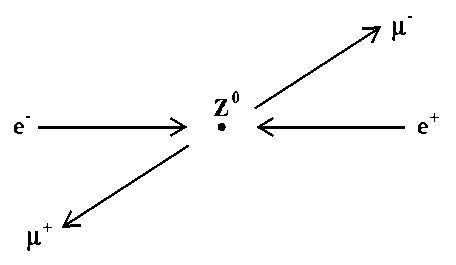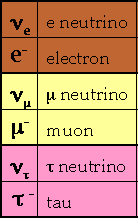
The world's largest particle accelerator lives in a tunnel that is 27 kilometers long and about 100 metres underground just outside Geneva in Switzerland. In the last couple of years the accelerator has been upgraded to allow the beams of particles to be accelerated to energies of more than twice that achieved previously. The purpose of these web pages is to allow you to identify for yourself some of the interesting events we have seen at this accelerator.
A simple example of the kind of collisions we study is shown schematically in the following picture:

This picture shows an electron (e-) and a positron (e+). A positron is the antimatter equivalent (or antiparticle) of an electron. In the accelerator beams of electrons and postrons fly towards one another at high energy. In the picture an e- and an e+ collide to produce a Z0 particle. Because the initial e- and e+ have momenta which are opposite in direction and equal in magnitude the Z0 has no net momentum and is, therefore, stationary. After a very short time (about 10-25 seconds) the Z0 decays to produce a muon (µ-) and an antimuon (µ+). The muon and antimuon then fly apart "back to back" with one another.
We surround the place where the Z0 is produced with detectors, which enable us to see the particles produced when it decays.
We group the different sorts of elementary particles into families. The first family we call the "leptons":

In addition to the electron and muon, that we have met above, a third member
of this family also carries an electric charge; this particle is
called the "tau".
Each of these three particles has a partner called a "neutrino".
Neutrinos carry no electric charge and can travel large distances through
matter without interacting.
They leave no tracks in our detector although sometimes we can deduce that a
neutrino was produced.
(You'll see how later on!)

The "up" and the "down" quark can be found inside protons and neutrons
(which themselves can be found inside atomic nuclei).
The heavier quarks can be made at particle accelerators or by the interactions
of cosmic rays in the upper atmosphere, but don't occur naturally on earth.
In the following sections, first we explain a little bit about the detectors we use to see the diferent kinds of particles as they travel through our experiment. Then, in several stages, we explain how to identify the different kinds of particle interactions or "events" that can occur (with some helpful examples to get you started). At each stage of the story we give you the challenge of playing particle detective yourself!
 Click here to proceed to the next part
of the program, which is
"The Detector and How to Understand the Event
Pictures".
Click here to proceed to the next part
of the program, which is
"The Detector and How to Understand the Event
Pictures".
 Back to Home Page with table of contents.
Back to Home Page with table of contents.